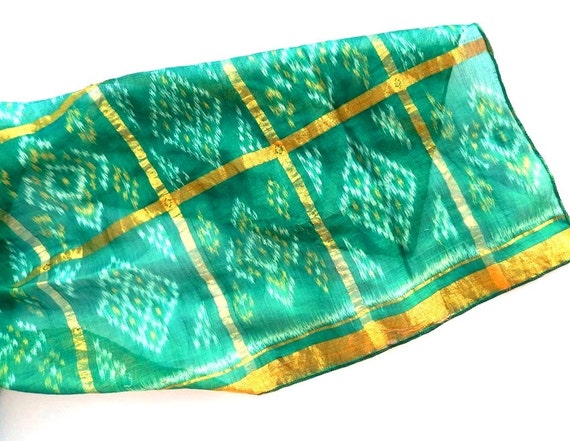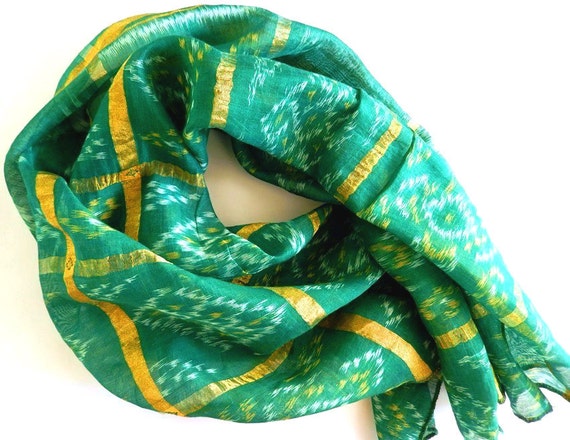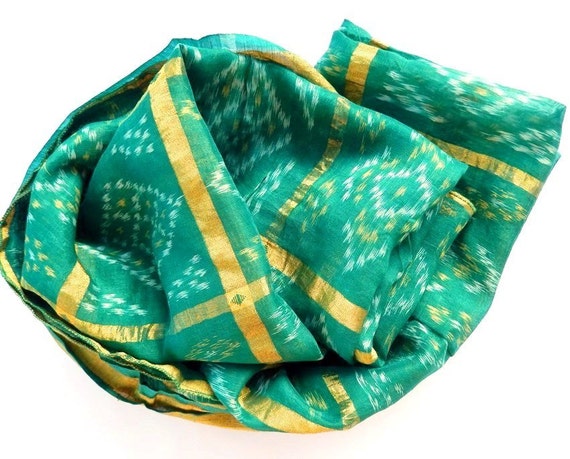This style of saree is created by Hindu or Jain Salvi weavers (Sal is Sanskrit for loom and Vi is the rosewood sword used in a Patola loom) exclusively in Patan, in the western province of Gujarat, India. Patola (from the Sanskrit pattakula, meaning "silk fabric") is a style of textile manufacture that involves double ikat, considered one of the most complex weaving techniques in the world. The process is incredibly time consuming. One sari can take a group of four or five weavers four months or longer to complete, and can cost over 10,000USD.
Single ikat "Patola" saris, like the one pictured above, are considerably less expensive and are more readily available to the humble textilian like myself.
Patola was favored by royalty and aristocracy. The saris were a sign of status, and were especially valuable to women as part of stridhan (a woman's own property within a marital household).
Double-ikat Patola saris were being produced by Jain craftspeople by the 7th century A.D. in southern India. King Kumarpal of Patan, then the capital of Gujarat, had an affinity for Jain traditions, and wore specially imported, new patola clothes when going to temples.
According to Gaatha:
One day, the temple priest barred Kumarpal from entering the temple by saying that his clothes were ‘impure’. An inquiry into this led to the finding that the king of Jalna was exporting the fabric after first using them as bedspreads. Deeply offended, Kumarpal fought and defeated the ruler of Jalna and brought 700 Salvi craftsmen to Patan so that he could be assured of procuring unsullied fabrics. It is believed that some weavers also came from Karnataka in addition to those that came from Maharashtra. At a later date, Kumarpal converted the Salvi families into Shwetamber Jains.
The distinctive long straight streets of Salvivad in Old Patan, once a hub of Patola weavers, were laid out so especially for stretching out warp threads.
Patola weaving techniques and patterns are handed down through generations and are closely guarded secrets. Today, only three families continue this tradition in Patan, and the waiting list for a sari is years long!
 |
| Single ikat Patola Sari on the Loom |
Dyes are traditionally naturally-derived, including Marigold Flower, Onion Skin,
Pomegranate rinds, Madder roots, Lac, Catechu, Cochineal, Indigo, manjistha, ratanjyot, mendhi,
katha, kesudo along with different mordant like alum, tin chloride, ferrous sulphate, copper sulphate,
Tennic Acid, Oxalic Acid, Potassium Dichromate etc.
Both sides of the finished textile are identical (there is no "right" side), and the colors remain true
for over a century!
According to Patola: A double ikat fabric from Patan (great description of double ikat technique):
In patola warp and weft silk threads are tied separately with cotton thread on the portions already
marked out in conformity with the proposed design in the fabric. This tied portion is meant to remain
unexposed to the color while dyeing. United portion which has absorbed one color may be tied while
dyeing in another color. Tying untying, retying and dyeing in different shades are the main features
of this process.
After completion of dyeing work of warps & wefts, the threads of the warp of different repeats of a
pattern are put together in a sequence on the loom, so that the design becomes visible. The threads
of wefts are wound on to bobbins and kept in the bamboo shuttle for weaving process.
The patola is woven on a primitive hand operated harness loom made out of rosewood and bamboo
strips. The loom lies at a slant, with the left side being lower than the right side. The bamboo shuttle
is made to move to and fro through warp sheds. Each weft thread is thoroughly examined and
matched with each part of the warp design pattern while weaving. The tension of the warp threads
are removed by the help of needle after every time weaving of 8" to 1 0" of fabric. Patola weaving is a
highly accurate just a positioning of warp and weft of similar color to obtain perfect design and harmony,
and while weaving the craftsperson has to ensure that the warp and weft threads intersect perfectly to
produce the pattern.
Patola sarees typically contain traditional Indian motifs that fall into one of the following categories:
Chhabdi/ Chaabri bhat: basket patternFulvali bhat: flowering patternPaan bhat: papal leaf patternRatan chown bhat: jewel mosaic, including geometric floral motifsAkhrot bhat: walnut motifOkhar bhat: water crossing designNari Kunjar bhat: parrot, women, and elephant designPopat kunjar: parrot and elephant designWagh bar hathi bhat/ Wagh kunjar bhat: : tigers and 12 elephants designVohra Cheer bhat: a geometrical pattern usually worn by Vohra Muslims at weddings and other auspicious days. Muslims stayed away from depictions of animals andhumans on their textilesMaharas bhat: women dancing keeping rhythm with sticks in their hands- a typical Gujarat folk designChowkhadi bhat: a diaper with double outline floral designThe square design represents security and protection
The cloths were highly sought after, and became symbols of wealth and power, passed on from
generation to generationas sacred heirlooms, ensuring the family's prosperity and health. They
are often worn or presented during baby showers and weddings.
By the 13th century, patola was exported in large quantities to Indonesia, Bali, Sumatra, Sulawesi,
Roti, and Lamalera. There they were considered a holy cloth with magical powers. They were used to wrap sacred
objects, adorn ceremonial palace beds, and were worn during ritual dances.
According to Gaatha:
A bridegroom may wear one over his shoulders as a lucky charm, or use it to drape his horse on his ride to the wedding ceremony.
In some Hindu and Jain communities, patola play a major role in the simanta or agharniceremony, which is celebrated in the seventh month of pregnancy. This phenomenon demonstrates that patola are auspicious and protect their wearer from sickness and misfortune. The cloths derive their magic power from their purity and holiness, which is inferred from the material, silk, but also from the fact that they are made by members of the higher Hindu and Jaina communities. Red and Green, the dominating colours, and certain motifs are considered to be auspicious and to ward off evil.
Good resources:
http://www.patanpatola.com/inside.html
http://gaatha.com/patan-na-patola/











Thank you for this beautiful,informative post
ReplyDeleteThanks so much for visiting!
Deletethe man weaving on loom is double ikkat weaving other then that nice post.
ReplyDeleteThanks, Paresh!
DeleteNice post!! Thanks for sharing.
ReplyDeleteIndian Sarees Online Shopping
Wedding Sarees Online
Designer Sarees Online
Traditional Sarees Online
Cotton Sarees Online
Silk Sarees Online
Online Salwar Kameez
Wedding Salwar Kameez Online
Designer Salwar Kameez Online
Party Wear Salwar Kameez Online
Cotton Salwar Kameez Online
Silk Punjabi Suits Online
Designer Kurtis online
Online Indo Western Apparel
great art
ReplyDeletefancy salwar kameez| best saree websites| designer wedding sarees| buy sarees online india| buy silk sarees online| kurtis online| latest designer salwar kameez
Nice collection and i like indian wedding sarees as they really look awsome andmany have emotions attached to it for long years
ReplyDeleteThis are is Great Thanks For Sharing his nice Article.
ReplyDelete